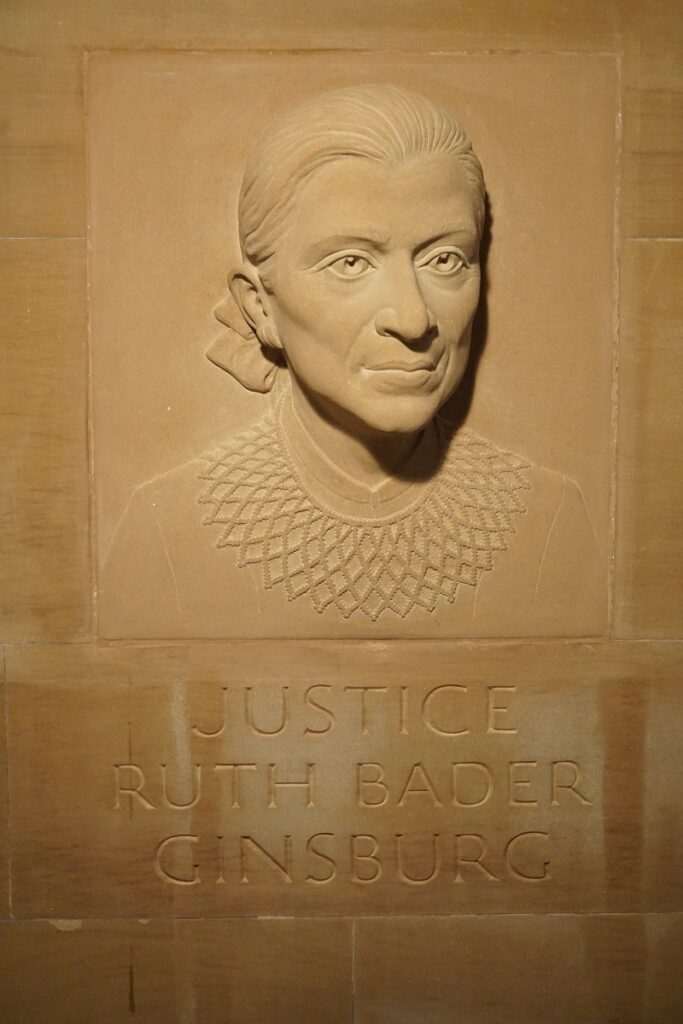Setting History in Stone
Norfolk Sculptor Participates in Project Honoring Ruth Bader Ginsburg
By Andra Moss
In late May, stone carver Adam Paul Heller of Norfolk received an unexpected phone call from the chief architect responsible for the New York State Capitol building. Would he be interested in joining a project underway at the capitol? It was extremely short notice, she admitted, but he would be contributing to an historic installation.

Photo curtesy of Adam Paul Heller
A statue honoring the late Supreme Court justice Ruth Bader Ginsburg was to be added to the Great Western Staircase of the capitol building, a magnificent 19th-century stone structure filled with ornate carvings, including 77 notable figures from early New York State history. The Ginsburg statue would be the first—and only the seventh likeness of a woman—to be added since 1898.
Heller did not hesitate. “She’s [Justice Ginsburg] such a figure of our time and a bridge ‘of the people’,” says Heller. “I just have so much respect for her. And for the sculpture to be placed in such an epic location…. I was very honored to participate.”
Meredith Bergmann, the sculptor who created the Women’s Rights Pioneers Monument in Central Park, had already been working on the Ginsburg piece for two years. Heller would carve the inscription.
As Heller describes it, the process of arriving at the lettering design for the four words, “Justice Ruth Bader Ginsburg,” was anything but simple. “I had only seven weeks to design, set samples and complete the project,” he explains. “That is an unusually short period for this work.” He immediately traveled to Albany for a site visit. The edifice had been built to impress, but perhaps only a stone carver could fully appreciate the immensity of the accomplishment and work involved. “The craftsmanship in this building is incredible,” marvels Heller. “The building was created over a 30-year period. Imagine hundreds of craftsmen all working on this building, making perfect seams, perfectly level staircases. There are details in the work that you can’t believe.”
In his Norfolk studio, a peaceful haven behind his family’s farmhouse on the edge of a wood, Heller unrolls several scrolls of brown paper upon which variations of the justice’s name can be seen. He points out the evolution of the design. “We tried several letter styles, several sizes.” He eventually decided on a 1-3/4 inch letter height of san serif letters (a style without extra strokes at the ends of the letters), as “the serif doesn’t read as well in the available light. We could make the san serif bolder.” The prominent site on the staircase wall selected for the sculpture is lit primarily by an overhead skylight. So, much of the decision, says Heller, was “basically about light.”
While this may be his first capitol commission, Heller is well-equipped to approach historic lettering. After receiving his bachelor’s degree in studio arts at the University of Vermont, Heller spent three years at the John Stevens Shop (est. 1705) in Newport, R.I., practicing the art of hand brushed letters, calligraphy, and hand carved stone. After relocating to Norfolk in 2014 with his wife and two children, Heller established his stone carving studio, receiving commissions for lettering and custom stone carving projects across the United States and Europe and working with many notable artists, including neo-conceptual artist Jenny Holzer.
The brown craft paper reveals more of Heller’s process. He begins by laying out faint guidelines and then draws each letter by hand in graphite. These are then filled in with paint using a narrow sable brush. Once fully satisfied, he moves on to a practice piece of stone. The staircase material, he notes, is Scottish sandstone, basically brownstone that “is very consistent and carves excellently.”
After just a few short weeks (“pretty much lightning speed”), Heller was ready to set the inscription on the staircase wall. Carving took seven days over two long weekends. The state police had to let him in on Saturdays and Sundays because the building was closed. Heller smiles at the memory. “You get to be in this gorgeous building by yourself; it was pretty special.”
Once the sculpture was installed along the wall between the second and third floors, Heller took over the scaffold. “I had a little place up there with a floor of boards across the poles and draped to try to create a studio environment inside—also so I didn’t have to look 45 feet down.”
Carefully, methodically, the three lines were laid out upon the sandstone. The center line was identified and the line heights established. Heller then made a fine trace of the letters from the final layout and transferred them onto the stone’s surface. These were then brushed by hand in a white water-soluble paint for greater visibility.
Heller describes the cuts: “I used two chisels; one is slightly rougher, and one is extra sharp for a crisp finish. You need this because it is a sandstone, and it can grind down a chisel.” Each cut is roughly a quarter inch deep. Heller begins with the bottom-right letter, he explains, “so that I don’t accidentally rub out anything to the right since my right forearm rests on the stone to give stability.” With every tap of his mallet, a single thin line joins the next until a letter, and then a word, is revealed.
With the official unveiling of the sculpture on Aug. 21, 2023, the artistry of the Norfolk stone carver and the powerful legacy of the Supreme Court justice from Brooklyn are now forever tied within the stones of an historic landmark.
More examples of Heller’s work can be found at AdamPaulHeller.com and his paintings will be featured in the exhibit “Field Lily” at the Oliver Wolcott Library in Litchfield from Sept. 7 through Oct. 25. The public is invited to the opening reception on Thursday, Sept. 7, from 5 to 7 p.m.
